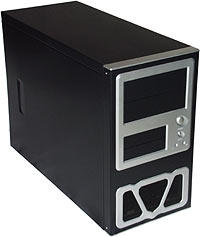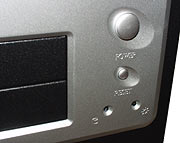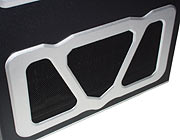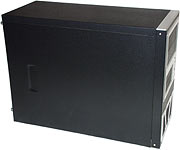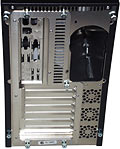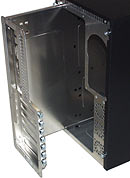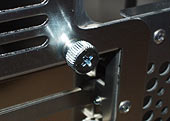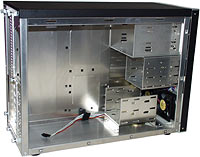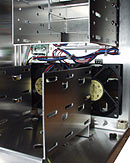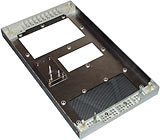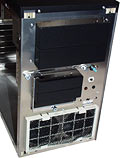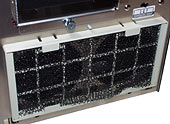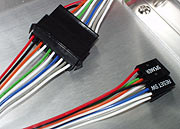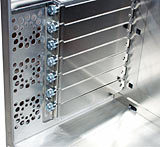
Lian Li PC-31 aluminium PC case
Review date: 12 January 2001.Last modified 03-Dec-2011.
Want a tasty PC case?
Decent expansion room, edges that don't slice you open, groovy styling?
Well, here y'go.
And it's even small!
Lian Li's PC-31 mini-tower case has a number of good points.
Good Point 1: It's black. If you want a black case - and you know you do - here it is.
Good Point 2: It's made of aluminium, so it's very light. 4.8 kilograms (10.6 pounds) without power supply. It won't rust, either.
Good Point 3: Mucho ventilation for your toasty-warm componentry. Two 80mm fans are mounted as standard at the bottom of the front panel.
Good Point 4: Lots of room. No fewer than eight drive bays, and a slide-out motherboard tray that'll take any ATX board you care to name.
OK, now the bad stuff.
Bad Point 1: It ain't cheap. Lian Li cases are very expensive, compared with the boxes in which most people's computers live. The PC-31 sells here in Australia for $AU275, delivered, from Aus PC Market. And that's without a Power Supply Unit (PSU).
For comparison, the cheapest cases Aus PC sell come with a power supply, and cost around the $AU90 mark; you can get a perfectly good AOpen midi-tower with a PSU for $AU130.
Bad Point 2: It's black. That's bad as well as good, because black cases may look funky, but good freakin' luck finding black-faced floppy and CD-ROM and DVD-ROM drives to match.
Such things exist, but not many places stock them. Directron in the States is an exception; they have a whole subsection for black components. But nobody but USAnians can order online from them.
Many people with an urge to own a black computer covered with black buttons that light up black when you press them therefore pry the beige bezels off their drives and paint or dye them to match the case.
Plain brushed metal finish cases don't look so dodgy with beige drive bezels breaking up the front panel. But beige on black looks, to coin a phrase, totally pants.
The PC31 doesn't have too serious a case of Black Box Disorder, though, because of its front panel decoration. The drive bay openings are surrounded by a silver plastic bezel.
Generally speaking, PC cases with cosmetic stuff stuck on them are A Bad Thing. Many Asian-made cases with bolt-on plastic end up looking like a pump-up running shoe for a battlemech.
They're cheap, I grant you, but it is my considered professional opinion that most of the darn things are totally goofy looking.
My personal favourite was the one with a bas-relief of Leonardo DiCaprio and Kate Winslet enjoying the breeze on the bows of the Titanic moulded into the case's front panel. James Cameron might have sued, if he could stop laughing long enough. Lian Li haven't decided to target the pink-Pokemon market, though, and the PC-31's plastic's pretty tasteful.
It bears close inspection, too. Fit and finish are excellent. Like the bigger PC-60 (which I review in detail here), the PC-31 may be expensive, but at least it looks it as well.
The front fan grille may be a bit too BMW-ish for you, but it could be a very great deal worse.
So what do you get for your money, besides a funky front panel?
Glad you asked.
The guided tour
The PC-31 is only about 370mm tall by 210mm wide (14.5 by 8.25 inches). And yet you can cram six 3.5 inch and two 5.25 inch devices into it, and still have room for a proper full-ATX motherboard.
The reason for this is simple enough - the case is a full 500mm deep (19.75 inches), if you count the sticky-out thumbscrews on the back panel.
Lian Li make three cases with this form factor.
The PC-30 has the same styling as the PC-60 - clean brushed aluminium, no front panel decoration to speak of. The PC-32 is a photo-negative of the PC-31 - it's brushed aluminium with black plastic for the front panel decoration, so wherever the PC-31 is silver, the PC-32 is black, and vice versa.
The PC-31's back panel. The Power Supply Unit (PSU) mounts vertically.
The PC-60 has a face-plate to which you screw the PSU, and then neatly slide it into the case; the PC-31 has the normal screw-it-straight-to-the-panel design.
The location of the PSU means that if you've got a motherboard that puts the CPU under the power supply - which most will - you can't use a really tall CPU cooler. Coolers like Thermaltake's giant Super Orb, for instance, are likely to foul the PSU.
You might not get a nifty PSU mount, but you do get a proper slide-out motherboard tray. Buy cheap steel cases and you generally have to get a pretty big one to get a motherboard tray - but smaller computers, with less room to move, arguably need a tray more than bigger ones.
The PC-31 tray has a total of 22 holes for you to choose from when you're inserting the neat little Lian Li snap-in screw receivers. This means it can accommodate practically any flavour of ATX motherboard.
Most motherboards these days use the Mini-ATX mounting holes, though they may not quite comply with the Mini-ATX form factor - some are a bit on the wide side. These boards can be a tight fit in some cases, especially if you're stacking the system with drives.
But the PC-31's deep design means it can fit fat Mini-ATX boards, full ATX boards, and microATX and flexATX boards as well, should you see no need to bother with more than a few expansion slots.
One corner of a full-ATX board may be shaded just slightly by the back of any hard drive you mount in the bottom bays - of which more in a moment - but I'd be surprised if you could come up with any ATX motherboard that didn't fit easily in the PC-31. Except, notably, for most current Pentium 4 motherboards, which need extra mounting points for the big heat sink on current P4 CPUs. The PC-31 lacks these holes.
The slide-off case sides and the tray are held in place with thumbscrews, so you don't need a screwdriver.
The inside view, with drive bays a-go-go.
At the bottom are three internal 3.5 inch bays. Like the PC-60, the PC-31's front fans blow cooling air right over these bays. Above them are three more 3.5s, in the normal drive-cage location. Two of those latter three bays have a front panel cut-out. At the top, there are two 5.25 inch bays, both with cut-outs.
The middle drive mount cage can easily be pulled out of the front of the case, as with the PC-60, and all of the bays have the same sharply bent sheet aluminium covers, not the click-in rattling plastic things that come with most cases.
Oh, and needless to say, there are none of those ghastly stamped metal inserts lurking behind the front bay covers, waiting for you to use roughly equal amounts of force and profanity to wiggle them free.
Another view of the lower bays and front fans. The little circuit board above and to the left of the fans is the speed control; you can set the fan speed using a switch hidden behind the front panel.
The first setting's about 40% power, for longer fan life and very little noise. Good if you're not packing your PC with drives. The middle, default, setting's about two-thirds power, and still quite quiet. The top, full power setting has the fans making as much noise as two 80mm fans can be expected to, and it's the only choice for the dedicated overclocker.
To get at the fan control switch, you just pop off the front panel...
...which is held on by some lovely zero-rattle plastic clips, better than the simple latch-clips used on the PC-60. Again, no tools are needed.
Most cases with decorative plastic on the front have the plastic held in place with squished-through melted-over pegs, or moulded clips. The PC-31 uses lots of screws, and all of the screws that would grind on the aluminium panel have a plastic washer to stop that from happening.
Here's the real front of the case...
...and here's the removable foam intake filter, and above it and to the right, the fan control switch.
You wouldn't think a thin open-cell foam filter like this would be a particularly good dust catcher, but the one on my PC-60 had a solid coating of fuzz after four and a bit months of service. The filters are easy to clean; you remove the front panel, pop off the plastic retainers on either side of the filter, then just carry it gingerly outside and blow through it in the general direction of someone with severe allergies.
As with the PC-60, the PC-31 has a connector in the middle of the case header leads. This lets you unplug just one thing when you slide out the motherboard, and leave all of the cryptic little LED and switch connectors as they are. It also, of course, allows you to plug all of those little headers in with the motherboard out of the case, rather than fiddling around with the thing already most of the way in.
The inside of the back panel. Note spiffy shiny steel slot covers (each with its own thumbscrew retainer, of course), and circle-pattern vent holes.
You could mount three 40mm fans here over the expansion card area for a bit more exhaust power, but I frankly doubt whether it'd make a great deal of difference. The twin front fans, especially on full power, should have about three times the air-moving ability of three 40mm units. So a respectable breeze will blow out of these holes whether or not you put more fans there.
Overall
If you want a black case that won't look completely ghastly with a beige drive-front or two showing, this could be the one for you.
Of course, if you're a studly business type looking for that Rand Corporation style, you can of course set up a machine in this box as a no-removable-drives workstation. What you save on building some simple Duron or Celeron machine into one of these cases, rather than buying a proprietary pizza box from a big name, you can spend on a flat screen monitor to keep your corporate-onanist schtick on track.
A no-drives PC-31 wouldn't be a bad choice for a network games room or cafe Web box, either; no floppy, no CD-ROM, no teenage punks futzing with your computers.
For the ordinary computer hobbyist looking for a snazzy enclosure, the PC-31's a pretty good choice. Apart from having sexy mirror-finish aluminium all over the place, the PC-31 is also easy to work on. The metal edges aren't sharp, the removable middle bays and motherboard tray let you easily get at otherwise fiddly bits, and everything that's meant to be a right angle actually is. So you don't need a panelbeater's mallet to get cards into slots.
Overclockers usually buy higher-powered PSUs along with their new cases anyway, so it's not a big deal that the PC-31 doesn't come with a power supply. And its price tag may be rather imposing, but it's only about as much as the average GeForce2 MX video card.
When I reviewed the PC-60, I built a full stacked computer into it, and I was impressed. It's not a huge case, but it's a very well done one, with most of the expansion capability of a proper tower in a much smaller enclosure. Many cases with lots of bays become a big pain to work with if you actually want to use all of the bays; the Lian Li cases aren't like that.
The PC-31's got essentially the same ingredients as the PC-60, in a slightly smaller serving.
Really, for most people, the only thing wrong with it is that if you're not in Australia you may have a hard time finding one. Here in Australia, Aus PC Market will fix you right up (click here to place an order!). US buyers can get Lian Li cases from JCL, and Leadman Electronics apparently also distribute them. In Canada, Tweakbox might be able to help you out. If you're somewhere else, though, Lian Li gear is apparently difficult to get, and international shipping for PC cases - even very light PC cases - is excitingly expensive.
If you can buy them locally, though, the Lian Li cases are an excellent foundation for a high performance PC. Recommended.
Buy a Lian Li case!
Aus PC Market don't sell this case any more, but they've got
plenty of others!
